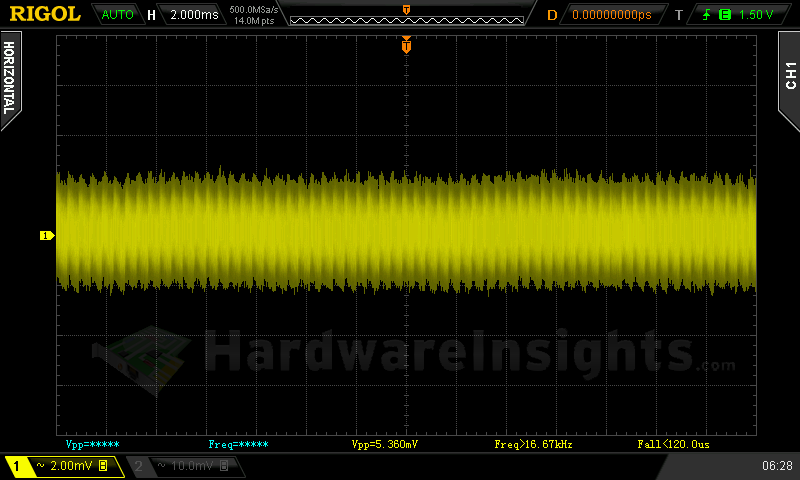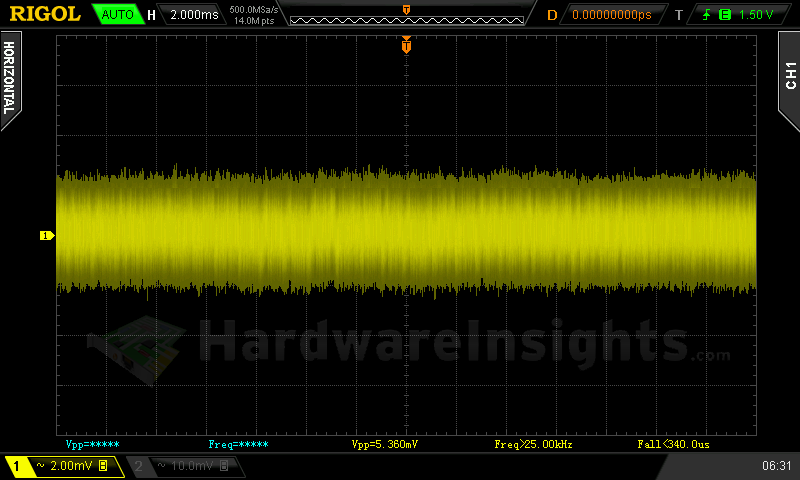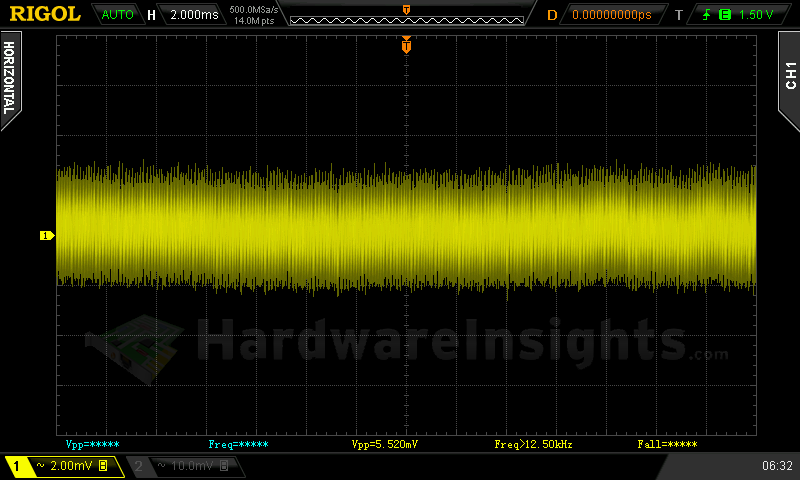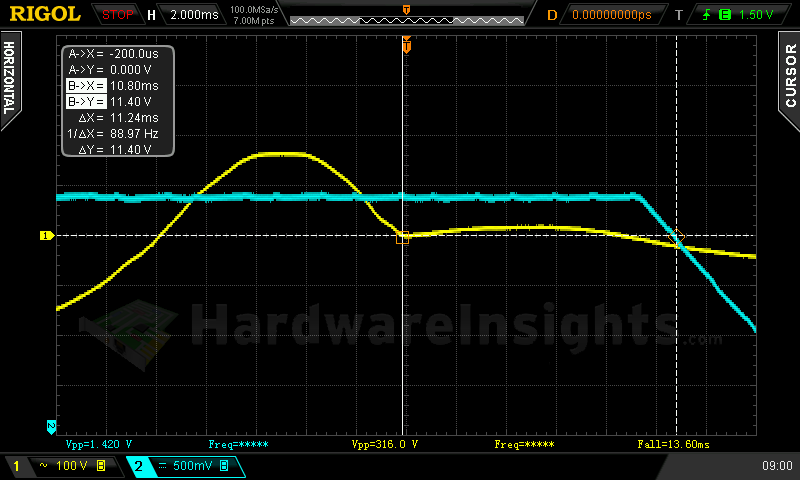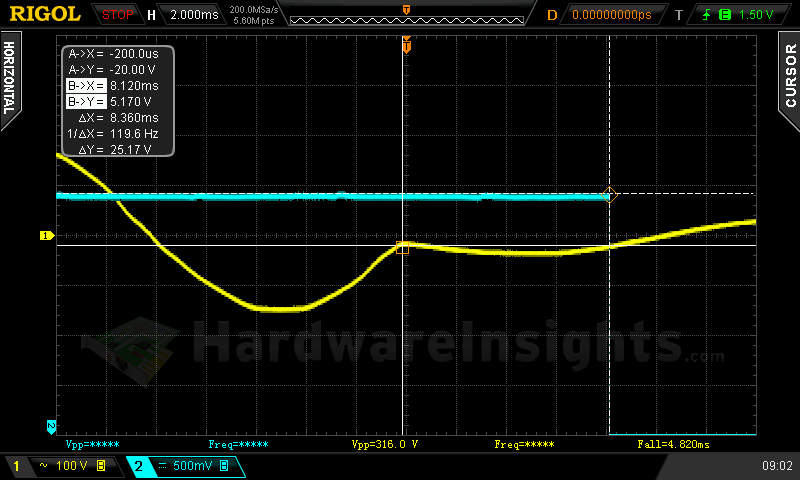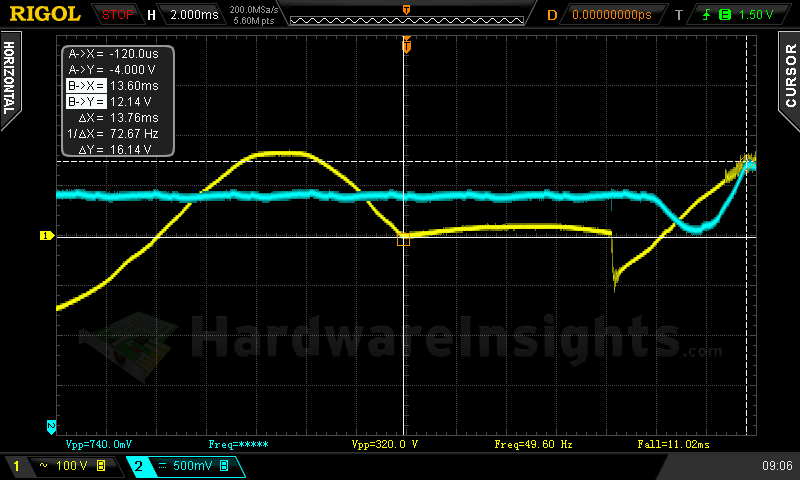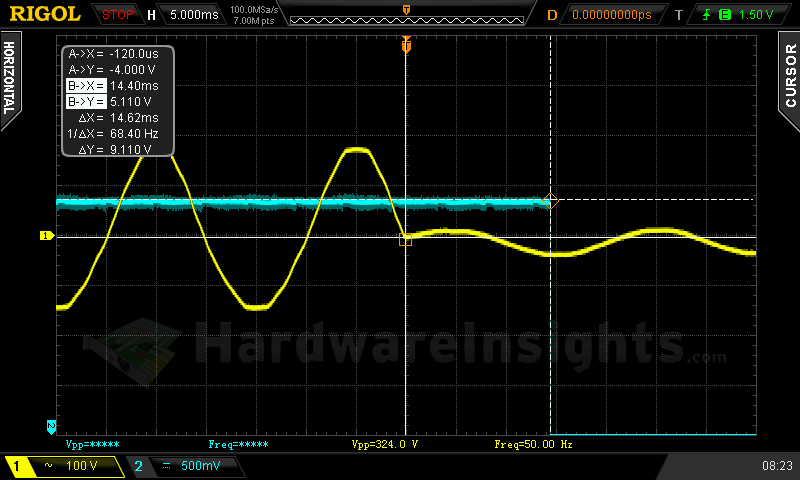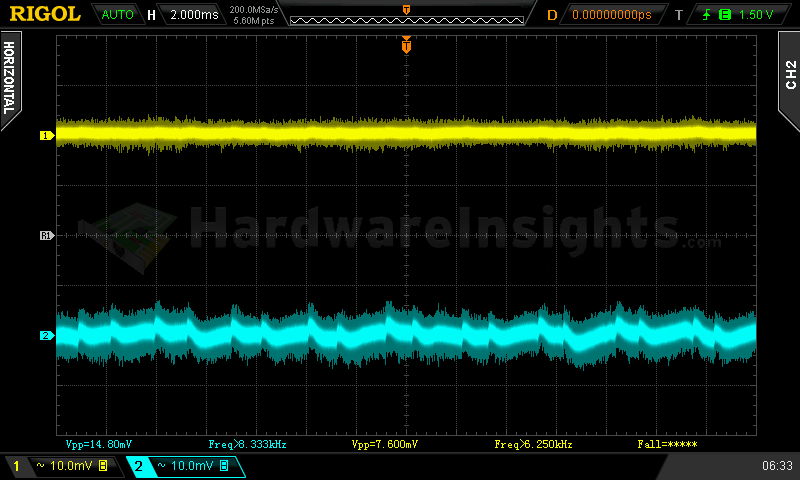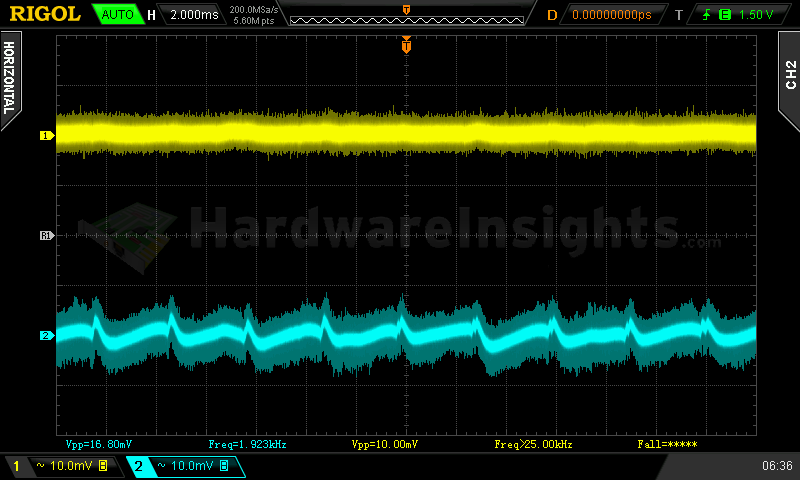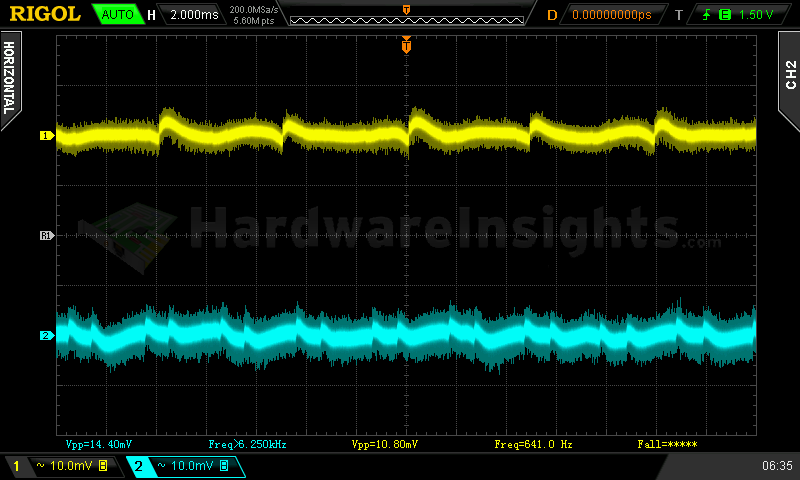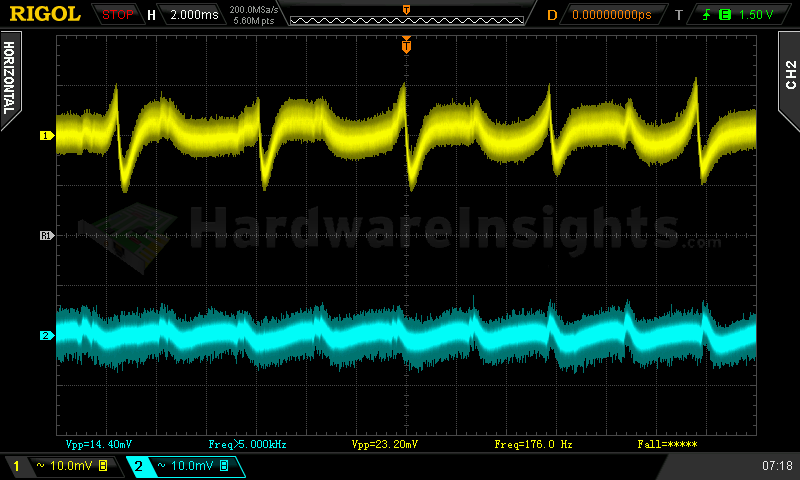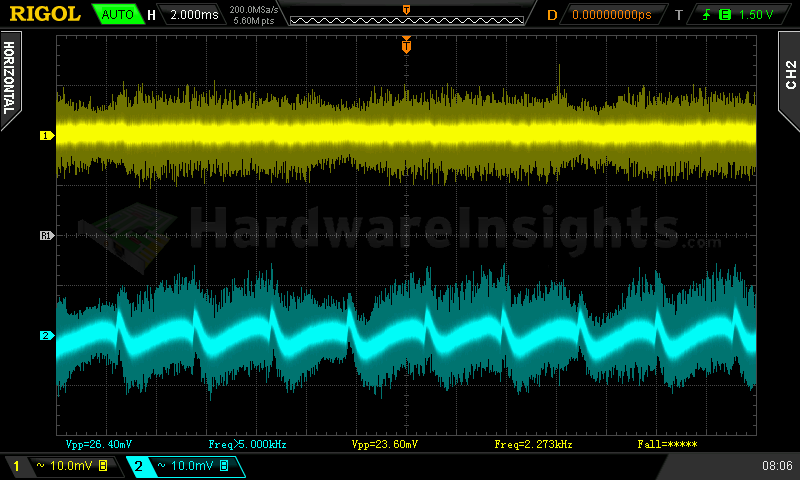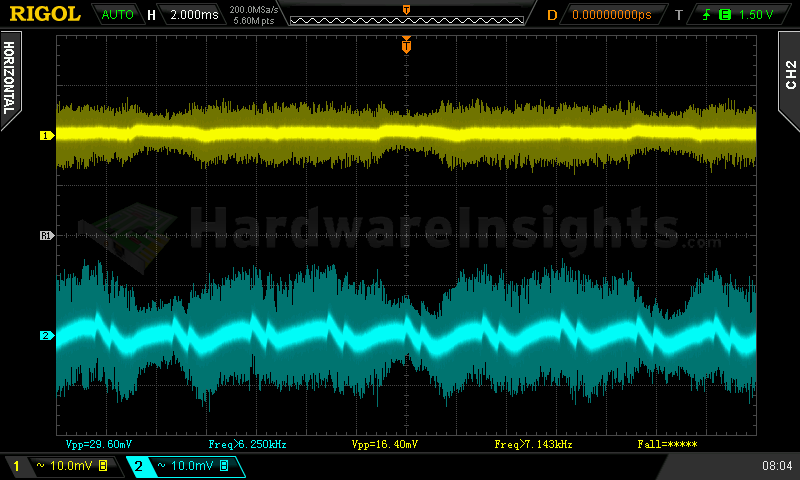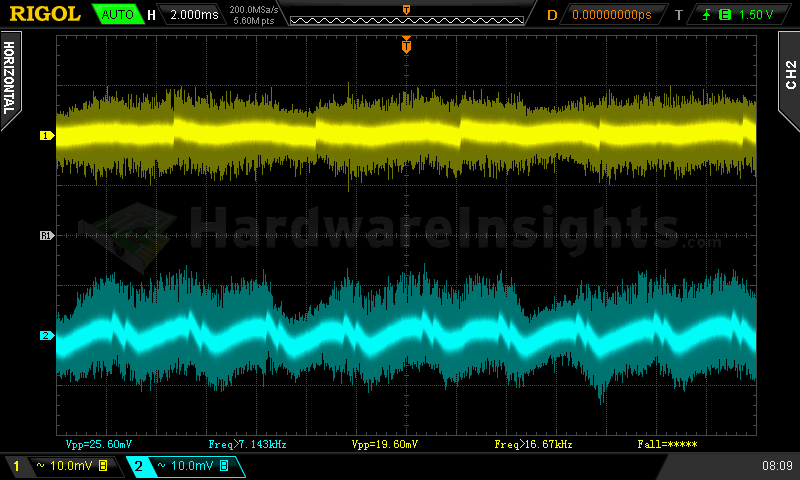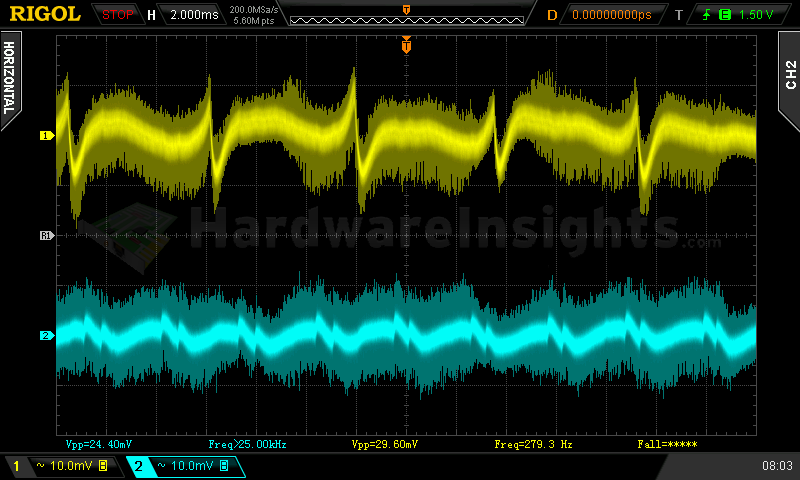Contents
- 1Introducing the SilentiumPC Elementum E1 SI-350 (SPC124)
- 1.1Packaging and accessories
- 2Connectors & cabling
- 2.1Casing & cooling
- 3Input filtering
- 4Primary side
- 4.1+5 V stand-by rail
- 5Secondary side
- 5.1Build quality
- 6Load testing
- 6.1Loading +5 V SB
- 6.2Hold-up time
- 6.3Combined loading
- 6.4Combined loading ripple
- 6.5Crossloading, overloading
- 6.6Crossloading, overloading ripple
- 6.7Fan speed, temperatures and noise
- 7Conclusion and evaluation
- 7.1Thanks
- 7.2Discussion
Load testing
Loading +5 V SB
As always, all load testing is done according to our testing methodology. The voltage regulation and ripple suppression is quite good for a low-end unit. Efficiency is lower than usual, though compared to most other cheap wonders we’ve looked at, it is still very good. As for overload, at over 3 A the stand-by controller shuts down.
| Output (W) | Load (A) | Voltage (V)/ ripple (mV) | Input (W) | Efficiency/power factor |
| 0 | 0 | 5.09/5.360 | 0 | —/0.014 |
| 12.20 | 2.43 | 5.03/5.360 | 17.08 | 71.4 %/0.508 |
| 14.66 | 2.92 | 5.02/5.520 | 20.42 | 71.8 %/0.532 |
+5 V SB ripple (left to right): 0 A; 2.91 A; 3.46 A
Hold-up time
As we can see on the oscilloscope screenshot, the hold-up time of the SI-350 +12 V rail is quite short, just 11.24 ms.
The hold-up time of the power good signal is is even shorter at only 8.360 ms. This just slightly over half the ATX minimum and even below my absolute minimum of 10 ms. Because of that this unit does not pass this test.
When interrupting for 8.36 ms, I saw some serious voltage spikes appear, which are over the maximum allowed (12.6 V). So I had to further decrease the time to just very slightly over 8 ms for the unit’s voltage regulation to stay within spec.
After the testing was done I went ahead and dug up some second-hand caps I have from other disassembled units. There I found an old Teapo LH 330/400. Because of the larger diameter it was smewhat tough to actually squeeze in the unit as there is not much extra space. But I managed to do so and with this bulk capacitor, the Power Good HUT increased to well over 14 ms.
I think that at the very least, a 220μF capacitor could be found with a comparable diameter, and with that the unit should manage at least 10 ms. Now with the 180μF garbage part that Fortech used, at full load, the unit may not withstand micro-blackouts even with a UPS in front of it without the PC restarting (if not outright shutting down completely).
Combined loading
Combined loading was OK for the SilentiumPC SI-350. Firstly, let’s talk about the voltage regulation. As this is an ordinary group design unit, the regulation is expected to be mediocre. And indeed, the voltages floated all over the spectrum depending on the combination of +5 and +12 V loads. Though in absolute values, the regulation is quite OK and within 2 %, this is a good result for a unit with such a low price.
| Output power | Load/ voltage +5 V SB | Load/ voltage +3.3 V | Load/ voltage +5 V | Load/ voltage +12 V | Load/ voltage −12 V | Input power | Efficiency/ power factor |
| 7.9 %/ 27.78 W | 0 A/ 5.08 V | 0.010 A/ 3.35 V | 0.410 A/ 5.08 V | 1.833 A/ 12.14 V | 0.294 A/ −11.59 V | 37.67 W | 73.7 %/ 0.573 |
| 20 %/ 71.66 W | 0.541 A/ 5.03 V | 1.483 A/ 3.34 V | 2.306 A/ 5.03 V | 4.00 A/ 12.22 V | 0.298 A/ −11.77 V | 87.95 W | 81.5 %/ 0.867 |
| 40 %/ 133.03 W | 1.03 A/ 5.01 V | 4.03 A/ 3.32 V | 3.43 A/ 5.01 V | 7.69 A/ 12.19 V | 0.299 A/ −11.87 V | 161.0 W | 82.6 %/ 0.981 |
| 60 %/ 210.84 W | 1.52 A/ 5.00 V | 5.41 A/ 3.32 V | 4.83 A/ 5.00 V | 12.98 A/ 12.14 V | 0.300 A/ −11.95 V | 255.2 W | 82.6 %/ 0.990 |
|
80 %/ 286.05 W |
1.87 A/ 4.99 V | 6.74 A/ 3.30 V | 5.98 A/ 4.99 V | 18.30 A/ 12.08 V | 0.302 A/ −12.03 V | 348.8 W | 82.0 %/ 0.991 |
| 100 %/ 346.37 W | 2.35 A/ 4.96 V | 8.67 A/ 3.30 V | 7.75 A/ 4.96 V | 21.9 A/ 12.06 V | 0.308 A/ −12.11 V | 431.3 W | 80.3 %/ 0.992 |
The efficiency is not that bad either. And even accounting for the variation of my clamp meter measurement, I still have the feeling that this unit would just barely pass the 80 PLUS 230V EU specification.
Combined loading ripple
The ripple values of the SI-350 are very nice for such an inexpensive unit.
| Output % | Ripple +5 V SB | Ripple +3.3 V | Ripple +5 V | Ripple +12 V | Ripple −12 V |
| 7.9 | 7.600 mV | 10.00 mV | 10.80 mV | 16.80 mV | 23.20 mV |
| 20 | 8.800 mV | 11.20 mV | 10.80 mV | 14.80 mV | 22.80 mV |
| 40 | 19.20 mV | 17.60 mV | 20.80 mV | 29.20 mV | 24.00 mV |
| 60 | 18.40 mV | 17.20 mV | 20.80 mV | 32.40 mV | 26.40 mV |
| 80 | 20.40 mV | 16.00 mV | 24.40 mV | 26.40 mV | 32.00 mV |
| 100 | 23.60 mV | 16.40 mV | 19.60 mV | 29.60 mV | 29.60 mV |
Ripple 7.9% load (left to right): +5 V SB; +3.3 V; +5 V; −12 V. The second channel is connected to +12 V.
Ripple 100% load (left to right): +5 V SB; +3.3 V; +5 V; −12 V. The second channel is connected to +12 V.
Crossloading, overloading
Crossloading tests brought out the worst side of this platform. Crossloading +3.3 and +12 V was still mostly OK, but a +5 V crossload pushed the voltage on +12 V rail too high. I even increased the load to over 42 watts from that rail and it was still out of spec. I would have expected that this would not be a problem with only a 15A rating for 350W unit, but obviously it was. This is the second failed test.
| Output power | Load/ voltage +5 V SB | Load/ voltage +3.3 V | Load/ voltage +5 V | Load/ voltage +12 V | Load/ voltage −12 V | Input power | Efficiency/ power factor |
| 30 %/ 104.10 W | 0.531 A/ 5.01 V | 20.47 A/ 3.32 V | 1.428 A/ 4.99 V | 1.830 A/ 12.30 V | 0.301 A/ −11.84 V | 146.5 W | 71.1 %/ 0.975 |
| 30 %/ 106.62 W | 0.532 A/ 5.02 V | 1.500 A/ 3.33 | 14.7 A/ 4.80 V | 1.931 A/ 12.75 V | 0.302 A/ −12.18 V | 135.5 W | 78.7 %/ 0.967 |
| 95 %/ 333.05 W | 0.529 A/ 4.99 V | 1.428 A/ 3.31 V | 1.552 A/ 5.12 V | 27.0 A/ 11.64 V | 0.294 A/ −11.76 V | 415.0 W | 80.3 %/ 0.992 |
| 129 %/ 451.03 W | 2.29 A/ 4.89 V | 1.33 A/ 3.28 V | 13.04 A/ 4.90 V | 31.3 A/ 12.06 V | 0.310 A/ −12.20 V | 600.3 W | 75.1 %/ 0.993 |
As for the protections, being the low-end unit that it is, I do not require anything but the basics (UVP, OVP, SCP). SilentiumPC states that the unit even has OPP and OCP, but as we have already discovered in the previous chapter, there is no OCP. As for OPP, it is not present either. There is only the ordinary power limiting on the primary side which resulted in a heavy voltage drop with a load higher than approximately 450 W. The unit turned off when the +12 V fell to about 9.5 V. I do not consider this to be properly functioning UVP either.
Crossloading, overloading ripple
The ripple was somewhat worse in this set of tests but still reasonable.
| Output % | Ripple +5 V SB | Ripple +3.3 V | Ripple +5 V | Ripple +12 V | Ripple −12 V |
| 30 | 12.40 mV | 12.00 mV | 16.00 mV | 24.40 mV | 20.40 mV |
| 30 | 21.60 mV | 9.200 mV | 28.00 mV | 29.20 mV | 30.40 mV |
| 95 | 18.00 mV | 12.00 mV | 34.80 mV | 32.40 mV | 30.00 mV |
| 129 | — | — | 32.80 mV | 26.80 mV | — |
Fan speed, temperatures and noise
The fan inside the SilentiumPC SI-350 started spinning right away. It seems to me that its maximum speed is about 1200 RPM, so while it does become audible at full speed, it’s not capable of reaching levels where it would become obviously loud.
| Output % | Fan speed (RPM) | Temperature intake/ outtake | Noise (dBA) |
| 7.9 | 785 | 26 °C/ 29 °C | 39.4 |
| 20 | 898 | 26 °C/ 30 °C | 39.5 |
| 40 | 1062 | 26 °C/ 33 °C | 39.9 |
| 60 | 1170 | 27 °C/ 34 °C | 39.9 |
| 80 | 1238 | 27 °C/ 39 °C | 40.5 |
| 100 | 1249 | 29 °C/ 45 °C | 40.5 |
| CL 30 | 1237 | 27 °C/ 38 °C | 40.5 |
| CL 30 | 1129 | 27 °C/ 34 °C | 40.2 |
| CL 95 | 1214 | 27 °C/ 42 °C | 40.5 |
| OL 129 | 1223 | – | 40.5 |
But it seems that the fan could have been spec’d to be slightly faster just to stay on the safe side as the unit was already getting quite hot under full load . The reason for this excess heat may also be because the efficiency drops quite a bit under full load. I also put this unit to the sweater test for 15 minutes. It survived but the exhaust air temperature reached about 70 °C. It got as hot as hell and started to smell badly. If the fan ever seizes in this unit, it would definitely die from ordinary use. With that being said, even under normal conditions but with poor case cooling, the cheap crapacitors will suffer greatly as the unit just plain runs hot.
